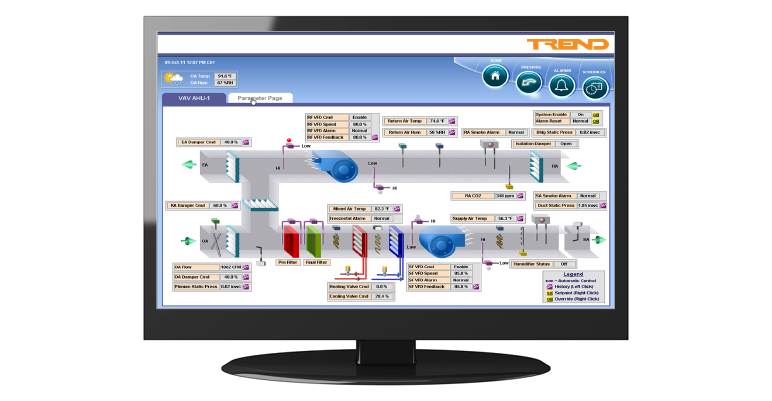How Big Data and AI is Changing Your Commercial Building Mechanical Systems
When you look back now at some of the predictions scientists and authors of the early 20th century were making about the time we’re living in now, it’s pretty amazing. Not just because some of those predictions were so far off, but more because of how incredibly accurate some of them turned out to be.
For example, as early as the 1950s, futurists recognized that computers were going to have a huge impact on the world, but there was no way they could have known just how wide ranging that impact would be. Still, many predictions that seemed like science fiction at the time have actually arrived. Consider: mobile phones, the Internet of Things, live video conferencing, machine learning and artificial intelligence. All of these technologies are being integrated today, but they were seemingly magical concepts several decades ago.

One category of striking predictions from the 50s postulated how thoroughly computer technology would be integrated into the systems and appliances operating our homes and commercial buildings. And, while most existing homes and buildings still don’t incorporate all of the automated and computer-controlled elements futurists thought would be available, many of those incredible features already exist, and they’re becoming more common.
Automation, Big Data, AI and your HVAC system
A perfect example of this technological evolution is in the HVAC system that heats, cools, and ventilates the average commercial building.
For most of its history, a commercial HVAC system consisted of essentially the same equipment (thermostats, heaters and air conditioners) that our homes used, but on a larger scale. Today, however, the technological trends affecting nearly every industry are changing commercial HVAC as well:
- There’s been a dramatic growth in computing power and speed
- Electronic components are shrinking in size even as they become more powerful
- Sensor technology has become far more affordable
- More data is being collected, stored, and analyzed, than ever before
Increased sophistication and lower cost
The result is that modern commercial HVAC systems have evolved into interconnected networks of sensors, hardware, and software that can be calibrated to offer maximum comfort and optimal energy efficiency under all operating conditions. What’s more, this level of sophistication no longer costs what it once did because the bulk of the power comes from the data and the software, not the more expensive hardware as it did in the past.
Is your commercial building Energy Star rated? Learn about the benefits for your building.
As a result, even average hardware (boilers, fans, chillers, etc.) can be upgraded and improved through quick and simple software updates instead of demanding an expensive and time-consuming replacement. So, the recommended lifespan of commercial HVAC equipment has effectively grown right along with all the other benefits of tech improvements.
Convenience and improved performance through automation
Another powerful effect of these advancements is the diminishing requirement of human operators. In some cases, it's no longer a need to spend hours manually calibrating and optimizing the HVAC system, as these recent advances in technology have allowed for more convenient — and more effective — smart building automation.
The increasingly automated and autonomous HVAC system now relies on embedded machine learning algorithms to continually review and analyze the incredible flood of data it collects to optimize the system in real time. Smart building automation improves energy efficiency, lowers operating costs, and boosts the mechanical state of the entire system.
Faster learning/training curve for implementation
Such technology can also make the training of new technicians and energy engineers faster and more effective because the software is not limited by an individual operator’s experience, knowledge or skill level. As a new software upgrade goes live, the entire system immediately improves without needing to wait for humans to catch up.
In the case of modern commercial HVAC systems, the seeming science fiction of the past truly is the reality of today.
What does this mean to you?
Of course, it’s fun to look back over the decades to see just how far technology has come. And, it’s amazing to consider where we might be in another 50 or 100 years. But there’s a much more important reason to think about the impact of Big Data, AI, and evolving technologies:
If you’re responsible for a commercial facility — whether you’re the owner, facility manager, or a maintenance technician charged with caring for the building’s mechanical systems — you need to ask yourself: how much of this amazing technology is already incorporated into our building? How well are we taking advantage of technology’s incredible possibilities?
In nearly every commercial building, improvements can be made. For instance, experts believe that, at this point, human beings never even look at 90% of the data that’s constantly being collected. If your building has control sensors and analytics software, what’s happening to the data those sensors are collecting? You’d probably be surprised how inexpensive and easy it is to get more out of that data, or to finally equip your building to start collecting and analyzing it in the first place.
In short, now’s a great time to review the state of your commercial HVAC system and optimize it for performance and efficiency, using the power of Big Data, AI, and smart building automation technology. If you need any help making this happen at your facility in the Carolinas or Virginia, we’d be delighted to discuss your goals and options.

